PacketCable PCMM
Develop a PacketCable PCMM/COPS southbound plugin and supporting modules to allow the OpenDayLight controller to provision CMTS as a network element that manages service flows with dynamic QoS.
packetcable
SCTE demo and ODL staged source can be found at GitHub.
Packet Cable MultiMedia (PCMM) provides an interface to control and management service flow for CMTS network elements. A service flows constitute a DOCSIS data path between a CMTS and a subscriber's cable modem (CM) guaranteed application specific quality of service (QoS), known as Dynamic Quality of Service (DQoS). PCMM offers (MSOs) the ability to deliver new services using existing cable infrastructure. MSOs have already begun to apply PCMM technology for expanding their multimedia service offerings.
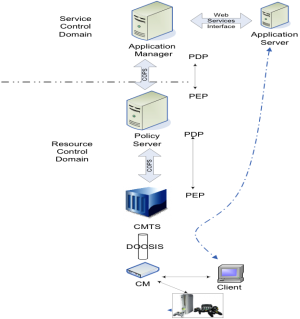
PCMM Overview
The PCMM architecture comprises the following components:
PacketCable Multimedia defines a service delivery framework that provides general-purpose QoS, event-based accounting, and security functionality founded upon the mechanisms defined in PacketCable 1.x. However, due to the broader spectrum of applications and services addressed by this initiative, each of these functional areas has been revisited and generalized for the present purposes. Telephony-specific requirements and interfaces (e.g., call signaling, PSTN interconnection and electronic surveillance) are not part of PacketCable Multimedia, while core functionality such as QoS resource management mechanisms, has been enhanced. Throughout this process, one of the primary objectives of this work has been to leverage and reuse as much of the existing body of PacketCable 1.x investment, knowledge base, and technical functionality as possible. Key features of the described Multimedia service delivery framework include:
The goal of this project is to utilizes the OpenDayLight controller platform as for the Application Manager and parts of the Policy Server and leverage the as many existing components offered by the platform.
The initial southbound transport has been written to the following version of the specification: http://www.cablelabs.com/wp-content/uploads/specdocs/PKT-SP-MM-I05-091029.pdf
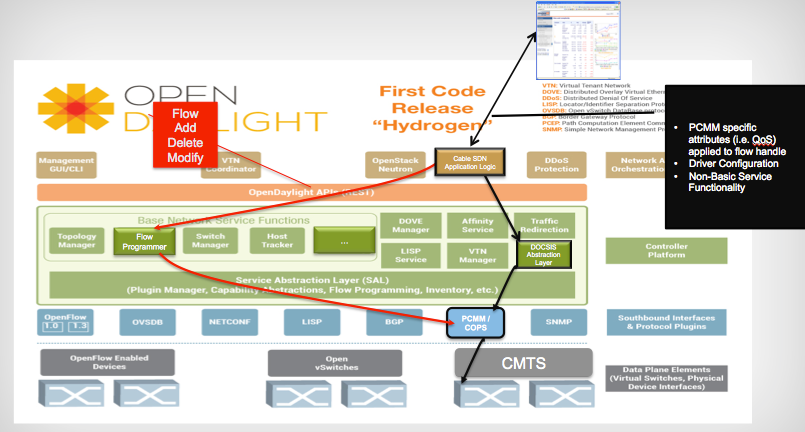
For example, add L2VPN Attributes (ID/Type/Value Encapsulation types, VLAN ID, etc).
This component is introduced at the Network Applications Orchestrations and Services layer. The component is proposed as an application responsible for the workflow logic that represents the use cases of interest: L2VPN, Buffer Management, Service Flow QoS Management, and general configuration automation.
This standard components exists at the Controller Platform layer and is responsible for programming flows at network elements that register support for flow management. It adheres to this FlowProgrammer Restful API.
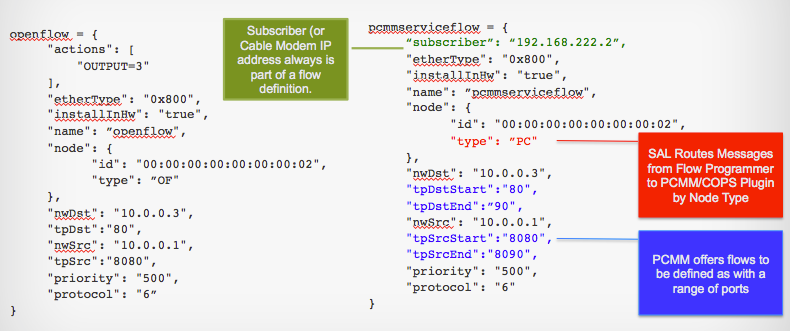
See PCMM Augmented FlowProgrammer
This component is introduced at the Controller Platform layer. This component manages the DOCSIS (and PCMM) specific attributes, such as store and change the default QoS values that are applied to Service Flows, and addition and removal of CMTS network elements. This module exports a DOCSIS specific northbound RESTful API as part of ODL architecture.
This component is introduced at the Southbound Interfaces & Protocol Plugins layer. This component is responsible for the PCMM/COPS/PDP functionality required to service requests from PacketCable Manager and FlowManager. Requests are transposed into PCMM Gate Control messages and transmitted via COPS to the CMTS. This plugin adheres to the PCMM/COPS/PDP functionality defined in the CableLabs specification.
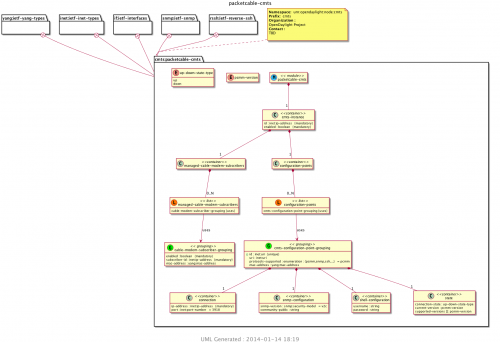
CMTS Inventory
CTMS Inventory Provisioning model is a draft adopted from OF-Config and contains some parameters for the future features that include interfacing to being able receive SNMP traps, read/write SNMP oid and configure using CLI. These services might even be provided by another southbound plugin. Unlike Openflow, discovery is not derived from a switch and provisioning is top down.
Flow Match Types and is a modification of the existing Openflow match action as a result of the comparison with Openflow.
Service Types are the northbound methods.
Flow Traffic Profile represents the various DOCSIS service flows that can be created.
PacketCable Service represents the northbound RPC service.
QoS (or Metering) are parameters pertaining to a service flow types. Is there a way to extended OF metering to adopt DOCSIS Dynamic QoS?

PCMM Traffic Profile

PCMM Service Flow Types
The following tables are comparisons with Openflow and PCMM ServiceFlows types. IPv6 is considered part of this comparison.
| OpenFlow | PCMM Service Flow |
|---|---|
| dlDst (MAC address) | no |
| dlSrc (MAC address) | no |
| vlanId | no |
| vlanPri | no |
| tosBits | nwDscp |
| SF Type | |
| nwProto (TCP or UDP protocol) | yes |
| ingressPort | CMIM |
| priority | yes |
| etherType | no |
| nwDst (Dest IP Address) | yes |
| nwDstMask | yes |
| nwSrc (Src IP Address) | yes |
| nwSrcMask | yes |
| tpSrc (Source Port) | sourcePortStart |
| sourcePortEnd | |
| tpDst (Destiation Port) | sourcePortStart |
| sourcePortEnd | |
| hardTimeout | no |
| idleTimeout | Timeout active QoS parameters |
| cookie | no |
| Activation State | |
| IPv6: Next Header Type, Flow Label, Flags, |
| OpenFlow | PCMM Service Flow |
|---|---|
| drop | yes UDC |
| loopback | |
| flood | |
| floodAll | |
| controller | |
| interface | |
| software path | |
| hardware path | |
| output | |
| enqueue | |
| setDlSrc | |
| setDlDst | |
| setVlan | In L2VPN, but not in PCMM |
| setVlanPcp | |
| setVlanCif | |
| stripVlan | |
| pushVlan | |
| setDlType | |
| setNwSrc | |
| setNwDst | |
| setNwTos | |
| setTpSrc | |
| setTpDst | |
| setNextHop | |
| pushMpls | |
| popMpls |
The CableLabs PCMM Specification defines the COPS PDP to PEP interface via a message set and set of object definitions. The objects carried in the COPS message set can be viewed as the PCMM COPS Information Model for the PCMM COPS interface between the Policy Manager and CMTS. The objects are represented in the table below.
| Object Name | Description | ODL YANG Exist? |
|---|---|---|
| TransactionID | Transaction Identifier used by the Policy Server to match responses from the CMTS to the previous requests. | Southbound Driver Internalized |
| AMID | Application Manager ID including the Application Manager Tag (Application responsible for handling the session) and Application Type (Type of application this gate is associated with). | Southbound Driver Internalized |
| SubscriberID | IPv4 or IPv6 address of the Subscriber for the service request (i.e., CM or CPE of Subscriber) | |
| GateID | Gate Identifier referenced in the command message or referenced by the CMTS for a response message. | Southbound Driver Internalized |
| GateSpec | Defines the following attributes:
parameters to be applied for this gate. Attributes include:
| Southbound Driver Internalized |
| Classifiers | Classifier, Extended Classifier or IPv6 Classifier | |
| Classifier |
| See Model |
| Extended Classifier |
| See Model |
| IPv6 Classifier |
| See Model |
| Traffic Profiles | FlowSpec, DOCSIS Service Class Name, DOCSIS-specific parameters or Upstream Drop | |
| Flow Spec |
| See Model |
| DOCSIS Service Class Name |
| See Model |
| Best Effort Service |
| See Model |
| Non-Real-Time Polling Service |
| See Model |
| Real-Time Polling Service |
| See Model |
| Unsolicited Grant Service |
| See Model |
| Unsolicited Grant Service with Activity Detection |
| See Model |
| Downstream Service |
| See Model |
| Upstream Drop |
| See Model |
| IPv4 Event Generation Info |
| No |
| IPv6 Event Generation Info |
| No |
| Volume-Based Usage Limit |
| No |
| Time-Based Usage Limit |
| No |
| Opaque Data |
Manager might store on a CMTS. | No |
| Gate Time Info |
| |
| Gate Usage Info |
| |
| PacketCable Error |
| Southbound Driver Internalized |
| Gate State |
| |
| Version Info |
| Southbound Driver Internalized |
| PSID |
| |
| Synch Options |
| |
| Msg Receipt Key |
| |
| UserID |
| Southbound Driver Internalized |
| SharedResourceID |
CMTS for Multicast Gate requests. |
Predefined flows with known quality of service parameters.
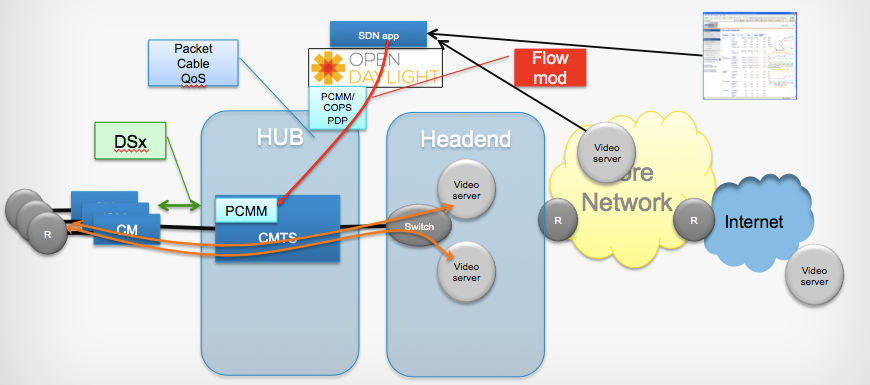
Use OpenFlow packetin to trigger a PCMM and Openflow flow creation.
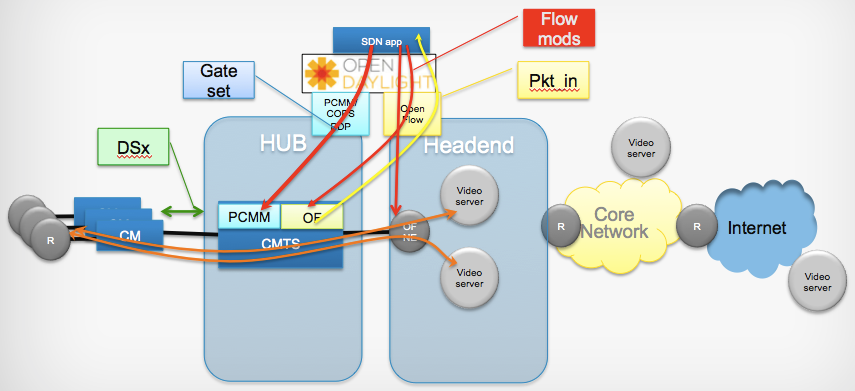
On 21 October 2013, a proof of concept PCMM southbound plugin was demonstrated at SCTE. This demonstration “shows” network flow manipulation by controlling DOCSIS video traffic flows from ODL and applying different PCMM metering parameters to creating a video image that was either degraded or high quality.
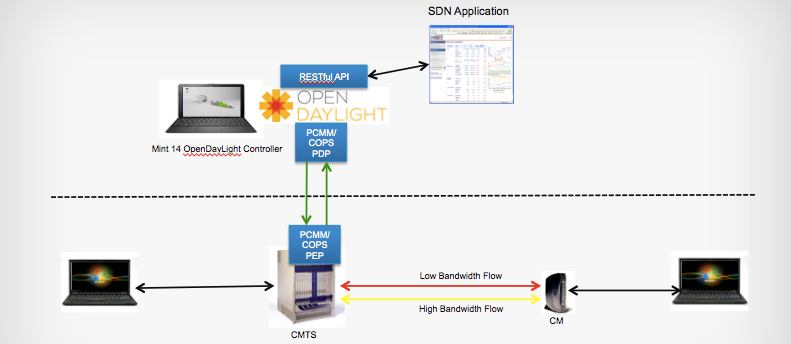
See Yang for CCAP
Since both devices optionally support the NETCONF protocol, these cable devices also optionally support YANG data models which are translated into mandatory supported XML Schema data models. The OpenDaylight framework also uses YANG models for their data model representation and tooling.
The CableLabs CCAP specification defines a UML Class Diagram Information Model for configuration management of PCMM in the CCAP device. This is represented in the figure below.
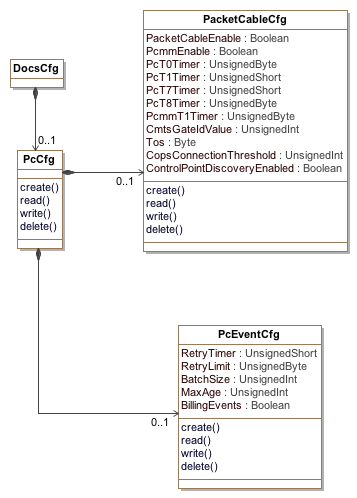
The above Information Model is translated into the YANG configuration management data module and corresponding XML Schema. Therefore, these objects and attributes can be provisioned via XML configuration files and optionally, if supported, via NETCONF messaging.
Latest (2014-04-02) CCAP Yang file.
Error creating thumbnail: Invalid thumbnail parameters
CCAP
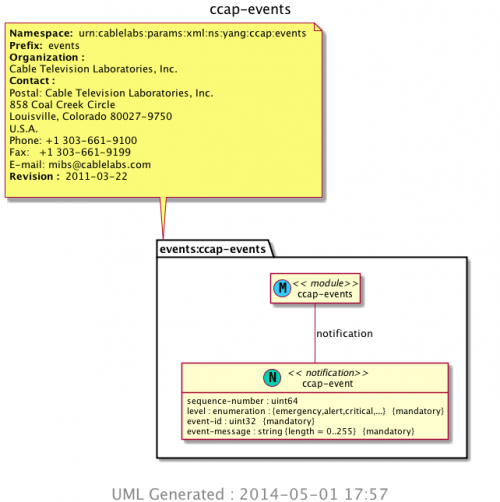
CCAP events
What is required in defining a service flow is the SubscriberID (or IP address). It would be useful to discover the Cable Modems (CM) that are being hosted and managed by a provisioned CMTS.
http://www.cisco.com/en/US/docs/cable/cmts/mib/reference/guide/ubrmibb.html
<docsIfCmtsCmStatusValue> <name>Registerd Modems</name> <method>walk</method> <source>value</source> <direction>output</direction> <oid>.1.3.6.1.2.1.10.127.1.3.3.1.9</oid> </docsIfCmtsCmStatusValue> DOCS-IF-MIB 1.3.6.1.2.1.10.127.1.3.3.1.2.1 docsIfCmtsCmStatusMacAddress.1 DOCS-IF-MIB 1.3.6.1.2.1.10.127.1.3.3.1.2.2 docsIfCmtsCmStatusMacAddress.2 DOCS-IF-MIB 1.3.6.1.2.1.10.127.1.3.3.1.2.3 docsIfCmtsCmStatusMacAddress.3 DOCS-IF-MIB 1.3.6.1.2.1.10.127.1.3.3.1.3.1 docsIfCmtsCmStatusIpAddress.1 DOCS-IF-MIB 1.3.6.1.2.1.10.127.1.3.3.1.3.2 docsIfCmtsCmStatusIpAddress.2 DOCS-IF-MIB 1.3.6.1.2.1.10.127.1.3.3.1.3.3 docsIfCmtsCmStatusIpAddress.3 DOCS-IF-MIB 1.3.6.1.2.1.10.127.1.3.3.1.4.1 docsIfCmtsCmStatusDownChannelIfIndex.1 DOCS-IF-MIB 1.3.6.1.2.1.10.127.1.3.3.1.4.2 docsIfCmtsCmStatusDownChannelIfIndex.2 DOCS-IF-MIB 1.3.6.1.2.1.10.127.1.3.3.1.4.3 docsIfCmtsCmStatusDownChannelIfIndex.3 DOCS-IF-MIB 1.3.6.1.2.1.10.127.1.3.3.1.5.1 docsIfCmtsCmStatusUpChannelIfIndex.1 DOCS-IF-MIB 1.3.6.1.2.1.10.127.1.3.3.1.5.2 docsIfCmtsCmStatusUpChannelIfIndex.2 DOCS-IF-MIB 1.3.6.1.2.1.10.127.1.3.3.1.5.3 docsIfCmtsCmStatusUpChannelIfIndex.3